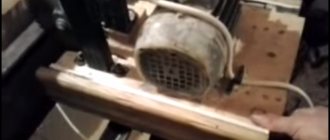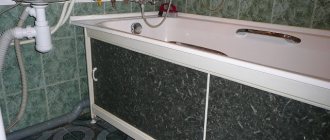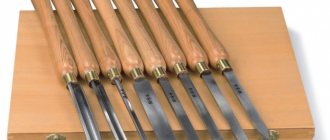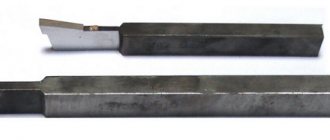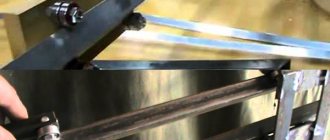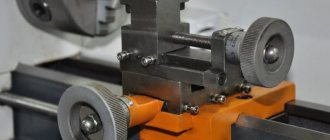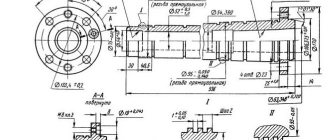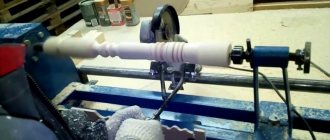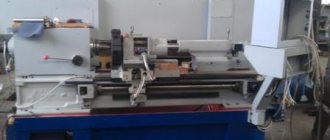Features of the slotting device
Professional and home-made machines have a similar, relatively simple design, which implements one of two cutting principles:
- using a movable working tool on a fixed tabletop;
- by feeding the part on a movable slide to the cutting element.
According to the location of the tool in relation to the workpiece:
- parallel to the tabletop, the cut occurs in a horizontal plane;
- perpendicular to the tabletop, with the drill moving in a vertical plane.
As a rule, when making a slotting machine yourself, the cutting tool is attached to the engine directly or through a belt drive and is located in a horizontal plane, parallel to the base. In more professional designs or homemade machines based on a press, milling or drilling machine, the working device has a vertical stroke relative to the base.
The main elements of the cutting part of the tool for a slotting machine
Principle of operation
According to their purpose, slotting machines are divided into two types: standard and specialized. Standard slotting machines are universal units that can be used to carry out a wide variety of operations. Specialized devices are designed for processing complex parts - punches, gears, etc.
The machines are driven by a drive. It can be equipped with three different types of mechanisms:
- crank;
- hydraulic;
- with a rotating scene.
The main processing tool is a hollow metal cutter (chisel) with a square drill inside. It is mounted on a vertical moving slider. The carriage allows you to drill even very large grooves in the workpiece.
The operating principle of the slotting machine is dual-mode. In the case of a simple mode, processing is carried out by repeated contact of the cutter with the workpiece at different points of the same plane. For example, a series of parallel holes of the same diameter and depth is drilled. A machine with a simple operating mode can be made manually.
In complex mode, the workpiece is processed in different planes, with multiple rotations of the carriage with the cutter in different directions, at different angles. This way you can drill grooves and recesses in hard-to-reach places on the part. Units operating in complex or combined modes are manufactured only using professional equipment. It is almost impossible to make such an installation at home yourself.
Structure and principle of operation of a slotting machine
A homemade slotting machine consists of the following main parts:
- a base on which a movable platform is installed for fastening carpentry blanks;
- electric motor with power up to 2 kW;
- shaft - at one end a belt drive is installed to the engine, at the other - a chuck for an actuating rotating tool (cutter, drill, cutter);
- parts holders, vices;
- levers for raising/lowering and adjusting the movement of the stand;
- on/off button;
- additional options, depending on work tasks.
General diagram of the slotting machine
The operating principle of a homemade slotting unit is based on the reciprocating movement of a rotating drilling and slotting tool. The process of making holes in wooden parts occurs according to the following scheme:
- the workpiece is installed on the stand and securely secured with a vice;
- the drill (cutter) is fixed in the shaft chuck, the motor starts;
- with a movable frame structure, the workpiece is fed to a drilling (slotting) tool, which makes a hole of the required parameters and configuration.
To obtain an elongated groove, the workpiece is moved perpendicular to the drill, the drilled holes are combined into a single sample. The stroke of the cutter, which can be adjusted, determines the sample size.
Making an elongated groove
Milling machine
To make a homemade slotter, you can use a hand router as a basis. This model will be inferior in functionality to factory machines. But with the help of this router it will be possible to cut tenons, grooves and profile planes or edges.
To make a slotting machine with our own hands, we will build a support platform. To select its dimensions, we focus on the dimensions of the parts that are planned to be processed in the future. The optimal size is 530x400 or 400x400 mm. Any piece of metal or MDF is suitable for making a platform, but fiberboard and chipboard are not suitable for this. The sheet should be 10–12 mm thick.
Next, in the center of the plate, you need to mark a hole for the cutter and transverse sockets for bolts for fixing the tool. The hole for the cutter should be slightly larger than the tool itself so that a clear view of the working area can be maintained. The milling cutter itself is fixed at the bottom of the plate using bolts; holes for them are provided on the support base of the tool at the factory.
Wood blocks of 30x30 cm will serve as guides to hold the platform - it is better to take hardwood. If a large-sized router is used, it would be reasonable to use a metal profile with a square cross-section or larger bars - 30x90 cm.
The design of this machine does not provide for a cutter stroke limiter - to equip it, the design needs to be significantly more complicated. A rational solution would be to use clamps as a limiter, which are installed on the part to be processed. Clamps are used using a very simple technology. The router should be moved so that the cutter is located on the edge of the hole. After this, we attach the clamp point-blank to the site, and then the router moves to the opposite side of the hole. Then we install the second clamp.
Source
Tools for slotting machine
The type of equipment, tools and consumables should be selected based on the planned volume of work. It is easier and more convenient for novice craftsmen to use ordinary drills. Experienced carpenters use professional slotting cutters and drills in their work - they allow them to obtain better and more accurate sockets in furniture elements and door structures.
Set of cutters for slotting machine
Electric drive of a homemade grooving machine
Various tools can be used as an electric drive to rotate the cutter: an electric drill, an angle grinder (grinder), a hand router or an electric motor.
Let's consider the advantages and disadvantages of various drive options for a homemade slotting machine:
- Wood slotting machine with electric drill. The simplest and most financially profitable option is to make a unit based on an electric drill. The advantages of this choice are the low cost and ease of installation of the drill. Among the disadvantages, it should be noted the low speed of operation due to the relatively low revolutions. It is not effective for cutting deep grooves, but it has proven itself well when chamfering and for work that does not require a lot of power.
- A hand router is essentially designed for this type of work, and when mounted on a frame, its functionality expands significantly. The costs in this case will be slightly higher, since the cost of such a tool exceeds the cost of the drill. Among the advantages, it is worth noting higher revolutions of the cutting tool, and therefore higher productivity.
- Use of an angle grinder (grinder). The advantages of using an angle grinder are high speeds and resistance of tool parts to lateral load on the shaft. The disadvantage is that the cutter is mounted on the shaft; you often have to use an adapter.
- Homemade wood slotting machine with an electric motor. The advantage of the electric motor is good performance due to high speeds. The disadvantage is the complexity of fastening and the use of additional parts: belt, spindle and others.
Making a machine yourself
There are many options for making a do-it-yourself wood slotting machine. Each master makes the device in accordance with available spare parts, skills and needs.
General diagram of the machine
With any choice, it is first useful to draw up drawings of the future equipment with verified dimensions. The dimensions of the installation must correspond to the work tasks and the room. It is not recommended to make a bed that is too large if you do not plan to process large parts - it is inconvenient to work with small parts and control the process at a massive workplace.
If there is an infrequent need for a slotting device, it is advisable to make it in a removable or portable form. On one table you can combine several types of homemade devices (drilling, cutting, etc.). The tool head can be mounted and removed as necessary, without cluttering the working surface of the machine, in small workshops.
Machine with stationary drill
The simplest type of homemade device from scrap materials that are always available in the home workshop:
- channel;
- engine from old household appliances;
- metal corners;
- thick plywood;
- bolts, nuts.
Manufacturing sequence:
- Install a piece of channel perpendicular to the working surface of the table - it will serve as the base for moving the platform.
- Attach the motor to the rear edge of the channel, and weld a metal strip to the front edge, the length of which is equal to the stroke of the carriage.
- Weld metal corners onto the edges of the strip.
- Perpendicular to the lower level of the platform, install a second upper level, assembled according to the same principle.
- Connect the levels to each other through a weld at the corners.
- Cut out the backing for the platform from plywood.
- Fix the wooden workpiece being processed using clamps or a vice.
- Before starting work, lubricate the rails with grease to ensure smooth running.
- Connect the electrical wiring to the motor.
Assembling a slotting machine
Machine made from a manual milling machine
To make a slotting machine at home, many carpenters prefer to use a manual milling cutter - a movable working tool has a number of advantages compared to a rigid mount. A good overview of the working surface and the ability to move it expand the functionality of the device and allow you to control the sampling depth.
General sequence of manufacturing work:
Making a slotting unit with your own hands
- From a sheet of plywood about 10 mm thick, cut a rectangle according to the dimensions of the router.
- Place wooden beams under the handles and secure with self-tapping screws.
- Firmly fix the router by pressing it to the base with metal pins. Use a level to properly fix the tool.
- Attach the lever for moving and adjusting the milling depth to another plywood base.
- Install guides for moving the router on the metal corners of the frame.
- Connect the units of the unit into a single working circuit.
- Place the wooden part for carpentry at the required level, placing blocks and fixing it with a vice.
- Connect the device to the network.
A wood slotting machine is designed to make grooves, grooves and other holes. Manual performance of these operations requires increased effort and time from the carpenter, and it is quite difficult to achieve the required level of accuracy and precision in performing the work.
Homemade equipment is not suitable for opening a furniture workshop, but it will fully cover the needs of a home craftsman. If you have welding and turning skills, you can assemble a drilling and slotting device with your own hands from scrap materials and devices.
Recommendations for creating a machine
You can easily make this equipment for your personal workshop. Before work, you need to prepare all the necessary equipment and important materials:
special engine;- metal corner;
- a piece of channel;
- thick plywood 4 mm;
- pieces of pipe;
- clamp;
- nuts
It’s also worth stocking up on two types of metal corners: the first piece should have a side of thirty mm, the second - fifty mm. Fastening will be done with 4 nuts.
